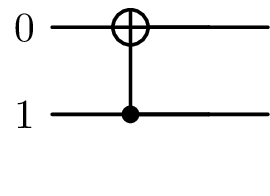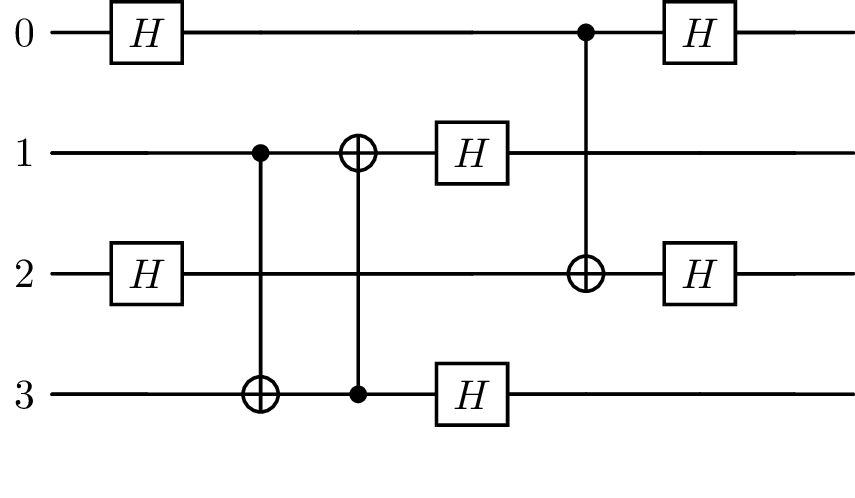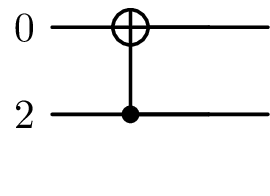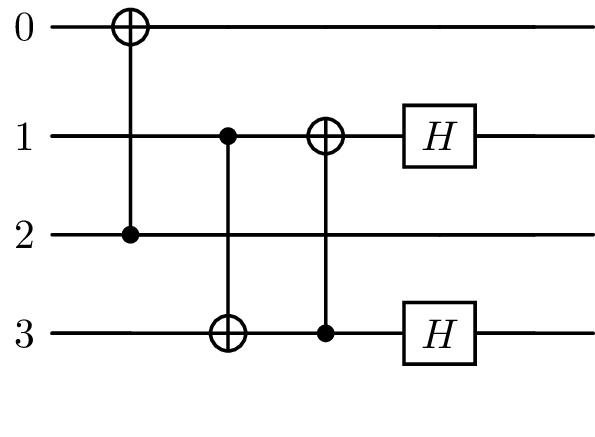4.4. Pattern replacer for geqo#
4.4.1. Background#
The pattern replacer is a tool that allows to automatically replace gates of a quantum circuit with other gates as specified by user-defined replacement rules, which we call pattern in the following.
For instance, two consecutive Pauli gates PauliX() on one qubit can be replaced by the idenitity. This means that Sequence([0], [], [(PauliX(), [0], []), (PauliX(), [0], [])]) can be replaced by Sequence([0], [], []). These two sequences can be used to define a pattern.
The pattern replacer comes along with tools to identify parts of circuits, that are suitable for a replacement. For instance, if there is another gate between the two PauliX gates, but operates on another qubit, then this gate can be filtered out. Furthermore, the tool contains a unification algorithm to match the names of bits, qubits and parameters of gates, which allows patterns to be applied to quantum circuits that use different names for these items.
from geqo.core import Sequence
from geqo.core import BasicGate, InverseBasicGate
from geqo.gates import PauliX, CNOT, Hadamard
from geqo.visualization import plot_latex
from geqo.simulators import ensembleSimulatorSymPy
from geqo.algorithms import (
Pattern,
findLongestRunSequence,
getAllLongestRuns,
getAllRuns,
)
4.4.2. Example: Eliminate double PauliX#
a sequence of two PauliX gates can be reduced to no gates at all
the pattern is defined with the input and the output sequence
inputSequence = Sequence([0], [], [(PauliX(), [0], []), (PauliX(), [0], [])])
outputSequence = Sequence([0], [], [])
lambdas = []
pat = Pattern("test1", inputSequence, outputSequence, lambdas)
print(pat)
Pattern #bits/#quits=0/1 and #lamdbas=0
the input pattern can be replaced with the output pattern with the function
replacerthe name of the qubit is automatically matched with the corresponding name in the pattern, which allows the pattern to be applied
seq = Sequence(["a"], [], [(PauliX(), ["a"], []), (PauliX(), ["a"], [])])
newSeq, subst = pat.replacer(seq)
print("used subst=", subst)
print("newSeq=", newSeq)
check sequence
run ix= 0
set qubits 0 to value a
res1/res2= True {}
run ix= 1
res1/res2= True {}
res1/res2/resQ/resC= True {} {0: 'a'} {}
replace_recursion called for Sequence([0], [], [])
used subst= {}
newSeq= Sequence(['a'], [], [])
4.4.3. Example: Replace two BasicGates with another one#
two basic gates with the same number of qubits can be merged into a single basic gate
the unitary operation corresponding to the new gate is the product of the two unitary operations of the two original gates
the definition of the parameter of the new gate can be obtained with lambda functions
the lambda functions can be used for the
setValuefunction of simulators
inputSequence = Sequence(
[0], [], [(BasicGate("x1", 1), [0], []), (BasicGate("x2", 1), [0], [])]
)
outputSequence = Sequence([0], [], [(BasicGate("y1", 1), [0], [])])
lambdas = [("y1", lambda x1, x2: x2 * x1)]
pat = Pattern("test2", inputSequence, outputSequence, lambdas)
print(pat)
Pattern #bits/#quits=0/1 and #lamdbas=1
the function
replaceris used to apply the patternthe names
x1andx2of the gates are automatically matched with the namesaandbof the pattern
seq = Sequence([0], [], [(BasicGate("a", 1), [0], []), (BasicGate("b", 1), [0], [])])
newSeq, subst = pat.replacer(seq)
print("used subst=", subst)
print("newSeq=", newSeq)
check sequence
run ix= 0
set qubits 0 to value 0
check basic gate
add pattern.name/target.name= x1 a
res1/res2= True {'x1': 'a'}
run ix= 1
check basic gate
add pattern.name/target.name= x2 b
res1/res2= True {'x1': 'a', 'x2': 'b'}
res1/res2/resQ/resC= True {'x1': 'a', 'x2': 'b'} {0: 0} {}
replace_recursion called for Sequence([0], [], [(BasicGate("y1", 1), [0], [])])
replace_recursion called for BasicGate("y1", 1)
replace basic gate
used subst= {'x1': 'a', 'x2': 'b'}
newSeq= Sequence([0], [], [(BasicGate("y1", 1), [0], [])])
4.4.4. Example: CNOT reversal with Hadamard gates#
a CNOT operation on qubits \(q_0\) and \(q_1\) can be turned into a CNOT on \(q_1\) and \(q_0\) by applying Hadamard gates before and after the gate
inputSequence = Sequence(
[0, 1],
[],
[
(Hadamard(), [0], []),
(Hadamard(), [1], []),
(CNOT(), [0, 1], []),
(Hadamard(), [0], []),
(Hadamard(), [1], []),
],
)
outputSequence = Sequence([0, 1], [], [(CNOT(), [1, 0], [])])
lambdas = []
pat = Pattern("test3", inputSequence, outputSequence, lambdas)
print(pat)
Pattern #bits/#quits=0/2 and #lamdbas=0
seq = Sequence(
[1, 0],
[],
[
(Hadamard(), [0], []),
(Hadamard(), [1], []),
(CNOT(), [0, 1], []),
(Hadamard(), [0], []),
(Hadamard(), [1], []),
],
)
newSeq, subst = pat.replacer(seq)
print("used subst=", subst)
print("newSeq=", newSeq)
check sequence
run ix= 0
set qubits 0 to value 0
res1/res2= True {}
run ix= 1
set qubits 1 to value 1
res1/res2= True {}
run ix= 2
res1/res2= True {}
run ix= 3
res1/res2= True {}
run ix= 4
res1/res2= True {}
res1/res2/resQ/resC= True {} {0: 0, 1: 1} {}
replace_recursion called for Sequence([0, 1], [], [(CNOT(), [1, 0], [])])
replace_recursion called for CNOT()
used subst= {}
newSeq= Sequence([0, 1], [], [(CNOT(), [1, 0], [])])
4.4.5. Example: Reverse BasicGate and InverseBasicGate#
the order of a
BasicGateand anInverseBasicGatecan be reversed if both have the same nameboth correspond to unitaries \(U\) and \(U^\dagger\), which commute
inputSequence = Sequence(
[0], [], [(BasicGate("X1", 1), [0], []), (InverseBasicGate("X1", 1), [0], [])]
)
outputSequence = Sequence(
[0], [], [(InverseBasicGate("X1", 1), [0], []), (BasicGate("X1", 1), [0], [])]
)
lambdas = []
pat = Pattern("test4", inputSequence, outputSequence, lambdas)
print(pat)
Pattern #bits/#quits=0/1 and #lamdbas=0
seq = Sequence(
["a"], [], [(BasicGate("u", 1), ["a"], []), (InverseBasicGate("u", 1), ["a"], [])]
)
newSeq, subst = pat.replacer(seq)
print("used subst=", subst)
print("newSeq=", newSeq)
check sequence
run ix= 0
set qubits 0 to value a
check basic gate
add pattern.name/target.name= X1 u
res1/res2= True {'X1': 'u'}
run ix= 1
check basic gate
res1/res2= True {'X1': 'u'}
res1/res2/resQ/resC= True {'X1': 'u'} {0: 'a'} {}
replace_recursion called for Sequence([0], [], [(InverseBasicGate("X1", 1), [0], []), (BasicGate("X1", 1), [0], [])])
replace_recursion called for InverseBasicGate("X1", 1)
replace inverse basic gate
replace_recursion called for BasicGate("X1", 1)
replace basic gate
used subst= {'X1': 'u'}
newSeq= Sequence(['a'], [], [(InverseBasicGate("u", 1), ['a'], []), (BasicGate("u", 1), ['a'], [])])
4.4.6. Finding candidates in a given sequence#
assume that we want to find sub-circuits on two qubits
if a qubit has a gate with an outsider qubit then it is burned
# The first qubit should lead to two Hadamard gates.
# The second qubit should get burned because of the gate with qubit 2.
seq = Sequence(
["0", "1", "2"],
[],
[
(Hadamard(), ["0"], []),
(Hadamard(), ["1"], []),
(CNOT(), ["1", "2"], []),
(Hadamard(), ["0"], []),
],
)
findLongestRunSequence(seq, 0, ["0", "1"])
(Sequence(['0', '1'], [], [(Hadamard(), ['0'], []), (Hadamard(), ['1'], []), (Hadamard(), ['0'], [])]),
[0, 1, 3])
4.4.7. A more complex example#
seq = Sequence(
[0, 1, 2, 3],
[],
[
(Hadamard(), [0], []),
(CNOT(), [1, 2], []),
(CNOT(), [2, 3], []),
(CNOT(), [0, 2], []),
(Hadamard(), [0], []),
(Hadamard(), [1], []),
],
)
findLongestRunSequence(seq, 0, [0, 1, 2])
(Sequence([0, 1, 2], [], [(Hadamard(), [0], []), (CNOT(), [1, 2], []), (Hadamard(), [1], [])]),
[0, 1, 5])
4.4.8. Automatically applying the reversal pattern with gates in between#
inputSequence = Sequence(
[0, 1],
[],
[
(Hadamard(), [0], []),
(Hadamard(), [1], []),
(CNOT(), [0, 1], []),
(Hadamard(), [0], []),
(Hadamard(), [1], []),
],
)
outputSequence = Sequence([0, 1], [], [(CNOT(), [1, 0], [])])
lambdas = []
pat = Pattern("Hadamard upside-down", inputSequence, outputSequence, lambdas)
print(pat)
Pattern #bits/#quits=0/2 and #lamdbas=0
seq = Sequence(
["0", "1", "2", "3"],
[],
[
(Hadamard(), ["0"], []),
(Hadamard(), ["2"], []),
(CNOT(), ["1", "3"], []),
(CNOT(), ["0", "2"], []),
(CNOT(), ["3", "1"], []),
(Hadamard(), ["0"], []),
(Hadamard(), ["2"], []),
],
)
subseq, indexes = findLongestRunSequence(seq, 0, ["0", "2"])
print(subseq)
print(indexes)
Sequence(['0', '2'], [], [(Hadamard(), ['0'], []), (Hadamard(), ['2'], []), (CNOT(), ['0', '2'], []), (Hadamard(), ['0'], []), (Hadamard(), ['2'], [])])
[0, 1, 3, 5, 6]
newSeq, subst = pat.replacer(subseq)
print(newSeq)
check sequence
run ix= 0
set qubits 0 to value 0
res1/res2= True {}
run ix= 1
set qubits 1 to value 2
res1/res2= True {}
run ix= 2
res1/res2= True {}
run ix= 3
res1/res2= True {}
run ix= 4
res1/res2= True {}
res1/res2/resQ/resC= True {} {0: '0', 1: '2'} {}
replace_recursion called for Sequence([0, 1], [], [(CNOT(), [1, 0], [])])
replace_recursion called for CNOT()
Sequence(['0', '2'], [], [(CNOT(), ['2', '0'], [])])
4.4.9. Example: A CNOT reversal operation with other gates between#
# The Hadamard conjugation of a CNOT leads to a flipped CNOT.
inputSequence = Sequence(
[0, 1],
[],
[
(Hadamard(), [0], []),
(Hadamard(), [1], []),
(CNOT(), [0, 1], []),
(Hadamard(), [0], []),
(Hadamard(), [1], []),
],
)
outputSequence = Sequence([0, 1], [], [(CNOT(), [1, 0], [])])
lambdas = []
pat = Pattern("Hadamard Upside-Down", inputSequence, outputSequence, lambdas)
print(pat)
Pattern #bits/#quits=0/2 and #lamdbas=0
sim = ensembleSimulatorSymPy(3, 0)
plot_latex(inputSequence, backend=sim, greek_symbol=True)

sim = ensembleSimulatorSymPy(3, 0)
plot_latex(outputSequence, backend=sim, greek_symbol=True)

seq = Sequence(
["0", "1", "2", "3"],
[],
[
(Hadamard(), ["0"], []),
(Hadamard(), ["2"], []),
(CNOT(), ["1", "3"], []),
(CNOT(), ["3", "1"], []),
(Hadamard(), ["1"], []),
(CNOT(), ["0", "2"], []),
(Hadamard(), ["0"], []),
(Hadamard(), ["3"], []),
(Hadamard(), ["2"], []),
],
)
sim = ensembleSimulatorSymPy(3, 0)
plot_latex(seq, backend=sim, greek_symbol=True)

subseq, indexes = findLongestRunSequence(seq, 0, ["0", "2"])
print(subseq)
print(indexes)
Sequence(['0', '2'], [], [(Hadamard(), ['0'], []), (Hadamard(), ['2'], []), (CNOT(), ['0', '2'], []), (Hadamard(), ['0'], []), (Hadamard(), ['2'], [])])
[0, 1, 5, 6, 8]
newSeq, subst = pat.replacer(subseq)
print(newSeq)
print(subst)
sim = ensembleSimulatorSymPy(3, 0)
plot_latex(newSeq, backend=sim, greek_symbol=True)
check sequence
run ix= 0
set qubits 0 to value 0
res1/res2= True {}
run ix= 1
set qubits 1 to value 2
res1/res2= True {}
run ix= 2
res1/res2= True {}
run ix= 3
res1/res2= True {}
run ix= 4
res1/res2= True {}
res1/res2/resQ/resC= True {} {0: '0', 1: '2'} {}
replace_recursion called for Sequence([0, 1], [], [(CNOT(), [1, 0], [])])
replace_recursion called for CNOT()
Sequence(['0', '2'], [], [(CNOT(), ['2', '0'], [])])
{}

Replace the gates in the original sequence directly
startIndex = 0 # We started here
print("we eliminate the indexes:", indexes)
newGatesAndTargets = []
for gi in range(len(seq.gatesAndTargets)):
# The first hit with our pattern is replaces
if gi == min(indexes):
# We have to place the substitution circuit here.
for g in newSeq.gatesAndTargets:
print("place in:", g)
newGatesAndTargets.append(g)
if gi not in indexes:
newGatesAndTargets.append(seq.gatesAndTargets[gi])
replacesSeq = Sequence(seq.qubits, seq.bits, newGatesAndTargets)
sim = ensembleSimulatorSymPy(3, 0)
plot_latex(replacesSeq, backend=sim, greek_symbol=True)
we eliminate the indexes: [0, 1, 5, 6, 8]
place in: (CNOT(), ['2', '0'], [])

4.4.10. Scan a whole circuit for a pattern#
the function
getAllLongestRunstakes a sequence and a number of qubits as inputsthe functions considers all possible combination of qubits with the specified number of qubits
for each combination of qubits, the longest possible sequences on these qubits are returned
a sequence cannot be extended on a qubit if there is a gate including a qubit, which is not part of the combination under consideration
in the following example, we get the longest possible subsequences on all pairs of qubits
seq = Sequence(
["0", "1", "2", "3"],
[],
[
(Hadamard(), ["0"], []),
(Hadamard(), ["2"], []),
(CNOT(), ["1", "3"], []),
(CNOT(), ["3", "1"], []),
(Hadamard(), ["1"], []),
(CNOT(), ["0", "2"], []),
(Hadamard(), ["0"], []),
(Hadamard(), ["3"], []),
(Hadamard(), ["2"], []),
],
)
getAllLongestRuns(seq, 2)
[(('0', '1'), [0]),
(('0', '1'), [4]),
(('0', '1'), [6]),
(('0', '2'), [0, 1, 5, 6, 8]),
(('0', '3'), [0]),
(('0', '3'), [7]),
(('1', '2'), [1]),
(('1', '2'), [4]),
(('1', '2'), [8]),
(('1', '3'), [2, 3, 4, 7]),
(('2', '3'), [1]),
(('2', '3'), [7]),
(('2', '3'), [8])]
in the following example, we get the longest possible sequences on single qubits
the CNOT operation prevents sequences from being extended because the other qubit is used
seq = Sequence(
["0", "1"],
[],
[
(Hadamard(), ["0"], []),
(Hadamard(), ["1"], []),
(CNOT(), ["0", "1"], []),
(Hadamard(), ["0"], []),
(Hadamard(), ["1"], []),
(Hadamard(), ["0"], []),
],
)
sim = ensembleSimulatorSymPy(3, 0)
plot_latex(seq, backend=sim, greek_symbol=True)
getAllLongestRuns(seq, 1)

[(('0',), [0]), (('0',), [3, 5]), (('1',), [1]), (('1',), [4])]
the result shows that only single Hadamard gates can be seen as a continuous sequence except for the two consecutive Hadamard gates on the first qubit
in the following example, the function
getAllRunsis used to get sequences on the specified number of qubits of a specific lengththis function is useful to find all possible candidates to apply a specific pattern, i.e. the number of qubits and gates can be specified
# The same as above, but we can ask for a length of the sub-sequence. For instance, if we have [0,1,2] as max.
# run and we have 2 as number of qubits, we get [0,1] and [1,2] at the end.
seq = Sequence(
["0", "1"],
[],
[
(Hadamard(), ["0"], []),
(Hadamard(), ["1"], []),
(CNOT(), ["0", "1"], []),
(Hadamard(), ["0"], []),
(Hadamard(), ["1"], []),
(Hadamard(), ["0"], []),
],
)
sim = ensembleSimulatorSymPy(3, 0)
plot_latex(seq, backend=sim, greek_symbol=True)
getAllRuns(seq, 2, 4, True)

scan qubits ('0', '1')
longest run: [0, 1, 2, 3, 4, 5]
processing candidate (('0', '1'), [0, 1, 2, 3, 4, 5]) len(candGates)/numberGates 6 4
new candidate: (('0', '1'), [0, 1, 2, 3])
new candidate: (('0', '1'), [1, 2, 3, 4])
new candidate: (('0', '1'), [2, 3, 4, 5])
[(('0', '1'), [0, 1, 2, 3]),
(('0', '1'), [1, 2, 3, 4]),
(('0', '1'), [2, 3, 4, 5])]
4.4.11. Example: Replacement of Toffoli gates#
a Toffoli gate can be decomposed into single qubit gates (Hadamard, \(T\) and \(T^\dagger\) gates) and 6 CNOT gates
for instance, see
https://en.wikipedia.org/wiki/Toffoli_gate#Related_logic_gatesas an example, we replace three Toffoli gates step by step
the Toffoli gates act on different qubits and the pattern matcher automatically adapts the patterns to the different qubits
from geqo.gates import Toffoli
inputSequence = Sequence([0, 1, 2], [], [(Toffoli(), [0, 1, 2], [])])
outputSequence = Sequence(
[0, 1, 2],
[],
[
(Hadamard(), [2], []),
(CNOT(), [1, 2], []),
(InverseBasicGate("pi4", 1), [2], []),
(CNOT(), [0, 2], []),
(BasicGate("pi4", 1), [2], []),
(CNOT(), [1, 2], []),
(InverseBasicGate("pi4", 1), [2], []),
(CNOT(), [0, 2], []),
(BasicGate("pi4", 1), [1], []),
(BasicGate("pi4", 1), [2], []),
(CNOT(), [0, 1], []),
(Hadamard(), [2], []),
(BasicGate("pi4", 1), [0], []),
(InverseBasicGate("pi4", 1), [1], []),
(CNOT(), [0, 1], []),
],
)
lambdas = []
pat = Pattern(
"toffoli",
inputSequence,
outputSequence,
lambdas,
)
print(pat)
Pattern #bits/#quits=0/3 and #lamdbas=0
in the following diagram, we visualize the gates that replace a Toffoli gate
the BasicGates with the name
pi/4correspond to \(T\) gates
from geqo.visualization import plot_mpl
sim = ensembleSimulatorSymPy(3, 0)
plot_mpl(outputSequence, backend=sim, greek_symbol=True)

we consider a sequence of 3 Toffoli gates
each gate should be replaced by the replacement sequence
seq = Sequence(
["a", "b", "c"],
[],
[
(Toffoli(), ["a", "b", "c"], []),
(Toffoli(), ["b", "c", "a"], []),
(Toffoli(), ["c", "a", "b"], []),
],
)
sim = ensembleSimulatorSymPy(3, 0)
plot_mpl(seq, backend=sim, greek_symbol=True)

we construct the replacement sequences for the first gate
the qubits are matched automatically
if there were parameters like rotation angles, these would also be matches automatically
newSeq1, subst1 = pat.replacer(
Sequence(["a", "b", "c"], [], [(Toffoli(), ["a", "b", "c"], [])])
)
check sequence
run ix= 0
set qubits 0 to value a
set qubits 1 to value b
set qubits 2 to value c
res1/res2= True {}
res1/res2/resQ/resC= True {} {0: 'a', 1: 'b', 2: 'c'} {}
replace_recursion called for Sequence([0, 1, 2], [], [(Hadamard(), [2], []), (CNOT(), [1, 2], []), (InverseBasicGate("pi4", 1), [2], []), (CNOT(), [0, 2], []), (BasicGate("pi4", 1), [2], []), (CNOT(), [1, 2], []), (InverseBasicGate("pi4", 1), [2], []), (CNOT(), [0, 2], []), (BasicGate("pi4", 1), [1], []), (BasicGate("pi4", 1), [2], []), (CNOT(), [0, 1], []), (Hadamard(), [2], []), (BasicGate("pi4", 1), [0], []), (InverseBasicGate("pi4", 1), [1], []), (CNOT(), [0, 1], [])])
replace_recursion called for Hadamard()
replace_recursion called for CNOT()
replace_recursion called for InverseBasicGate("pi4", 1)
replace inverse basic gate
replace_recursion called for CNOT()
replace_recursion called for BasicGate("pi4", 1)
replace basic gate
replace_recursion called for CNOT()
replace_recursion called for InverseBasicGate("pi4", 1)
replace inverse basic gate
replace_recursion called for CNOT()
replace_recursion called for BasicGate("pi4", 1)
replace basic gate
replace_recursion called for BasicGate("pi4", 1)
replace basic gate
replace_recursion called for CNOT()
replace_recursion called for Hadamard()
replace_recursion called for BasicGate("pi4", 1)
replace basic gate
replace_recursion called for InverseBasicGate("pi4", 1)
replace inverse basic gate
replace_recursion called for CNOT()
the replacement sequence for the first Toffoli gate is now stored in
newSeq1with the following loop, the first gate of a matched pattern is replaced by the replacement sequence
the further gates of a matched pattern are ignored, because the gates are replaced by other gates
indexes = [0] # Replace the first Toffoli
startIndex = 0 # We started here
print("we eliminate the indexes:", indexes)
newGatesAndTargets = []
for gi in range(len(seq.gatesAndTargets)):
# The first hit with our pattern is replaces
if gi == min(indexes):
# We have to place the substitution circuit here.
for g in newSeq1.gatesAndTargets:
print("place in:", g)
newGatesAndTargets.append(g)
if gi not in indexes:
newGatesAndTargets.append(seq.gatesAndTargets[gi])
replacesSeq = Sequence(seq.qubits, seq.bits, newGatesAndTargets)
sim = ensembleSimulatorSymPy(3, 0)
plot_mpl(replacesSeq, backend=sim, greek_symbol=True)
we eliminate the indexes: [0]
place in: (Hadamard(), ['c'], [])
place in: (CNOT(), ['b', 'c'], [])
place in: (InverseBasicGate("pi4", 1), ['c'], [])
place in: (CNOT(), ['a', 'c'], [])
place in: (BasicGate("pi4", 1), ['c'], [])
place in: (CNOT(), ['b', 'c'], [])
place in: (InverseBasicGate("pi4", 1), ['c'], [])
place in: (CNOT(), ['a', 'c'], [])
place in: (BasicGate("pi4", 1), ['b'], [])
place in: (BasicGate("pi4", 1), ['c'], [])
place in: (CNOT(), ['a', 'b'], [])
place in: (Hadamard(), ['c'], [])
place in: (BasicGate("pi4", 1), ['a'], [])
place in: (InverseBasicGate("pi4", 1), ['b'], [])
place in: (CNOT(), ['a', 'b'], [])

we now create the replacement gates for the second Toffoli gate
newSeq2, subst2 = pat.replacer(
Sequence(["a", "b", "c"], [], [(Toffoli(), ["b", "c", "a"], [])])
)
check sequence
run ix= 0
set qubits 0 to value b
set qubits 1 to value c
set qubits 2 to value a
res1/res2= True {}
res1/res2/resQ/resC= True {} {0: 'b', 1: 'c', 2: 'a'} {}
replace_recursion called for Sequence([0, 1, 2], [], [(Hadamard(), [2], []), (CNOT(), [1, 2], []), (InverseBasicGate("pi4", 1), [2], []), (CNOT(), [0, 2], []), (BasicGate("pi4", 1), [2], []), (CNOT(), [1, 2], []), (InverseBasicGate("pi4", 1), [2], []), (CNOT(), [0, 2], []), (BasicGate("pi4", 1), [1], []), (BasicGate("pi4", 1), [2], []), (CNOT(), [0, 1], []), (Hadamard(), [2], []), (BasicGate("pi4", 1), [0], []), (InverseBasicGate("pi4", 1), [1], []), (CNOT(), [0, 1], [])])
replace_recursion called for Hadamard()
replace_recursion called for CNOT()
replace_recursion called for InverseBasicGate("pi4", 1)
replace inverse basic gate
replace_recursion called for CNOT()
replace_recursion called for BasicGate("pi4", 1)
replace basic gate
replace_recursion called for CNOT()
replace_recursion called for InverseBasicGate("pi4", 1)
replace inverse basic gate
replace_recursion called for CNOT()
replace_recursion called for BasicGate("pi4", 1)
replace basic gate
replace_recursion called for BasicGate("pi4", 1)
replace basic gate
replace_recursion called for CNOT()
replace_recursion called for Hadamard()
replace_recursion called for BasicGate("pi4", 1)
replace basic gate
replace_recursion called for InverseBasicGate("pi4", 1)
replace inverse basic gate
replace_recursion called for CNOT()
we replace the first remaining Toffoli gate with the appropriate sequence
indexes = [15] # Replace the first Toffoli
startIndex = 0 # We started here
print("we eliminate the indexes:", indexes)
newGatesAndTargets = []
for gi in range(len(replacesSeq.gatesAndTargets)):
# The first hit with our pattern is replaces
if gi == min(indexes):
# We have to place the substitution circuit here.
for g in newSeq2.gatesAndTargets:
print("place in:", g)
newGatesAndTargets.append(g)
if gi not in indexes:
newGatesAndTargets.append(replacesSeq.gatesAndTargets[gi])
replacesSeq = Sequence(replacesSeq.qubits, replacesSeq.bits, newGatesAndTargets)
sim = ensembleSimulatorSymPy(3, 0)
plot_mpl(replacesSeq, backend=sim, greek_symbol=True)
we eliminate the indexes: [15]
place in: (Hadamard(), ['a'], [])
place in: (CNOT(), ['c', 'a'], [])
place in: (InverseBasicGate("pi4", 1), ['a'], [])
place in: (CNOT(), ['b', 'a'], [])
place in: (BasicGate("pi4", 1), ['a'], [])
place in: (CNOT(), ['c', 'a'], [])
place in: (InverseBasicGate("pi4", 1), ['a'], [])
place in: (CNOT(), ['b', 'a'], [])
place in: (BasicGate("pi4", 1), ['c'], [])
place in: (BasicGate("pi4", 1), ['a'], [])
place in: (CNOT(), ['b', 'c'], [])
place in: (Hadamard(), ['a'], [])
place in: (BasicGate("pi4", 1), ['b'], [])
place in: (InverseBasicGate("pi4", 1), ['c'], [])
place in: (CNOT(), ['b', 'c'], [])

we create the replacement sequence for the remaining Toffoli gate
newSeq3, subst3 = pat.replacer(
Sequence(["a", "b", "c"], [], [(Toffoli(), ["c", "a", "b"], [])])
)
check sequence
run ix= 0
set qubits 0 to value c
set qubits 1 to value a
set qubits 2 to value b
res1/res2= True {}
res1/res2/resQ/resC= True {} {0: 'c', 1: 'a', 2: 'b'} {}
replace_recursion called for Sequence([0, 1, 2], [], [(Hadamard(), [2], []), (CNOT(), [1, 2], []), (InverseBasicGate("pi4", 1), [2], []), (CNOT(), [0, 2], []), (BasicGate("pi4", 1), [2], []), (CNOT(), [1, 2], []), (InverseBasicGate("pi4", 1), [2], []), (CNOT(), [0, 2], []), (BasicGate("pi4", 1), [1], []), (BasicGate("pi4", 1), [2], []), (CNOT(), [0, 1], []), (Hadamard(), [2], []), (BasicGate("pi4", 1), [0], []), (InverseBasicGate("pi4", 1), [1], []), (CNOT(), [0, 1], [])])
replace_recursion called for Hadamard()
replace_recursion called for CNOT()
replace_recursion called for InverseBasicGate("pi4", 1)
replace inverse basic gate
replace_recursion called for CNOT()
replace_recursion called for BasicGate("pi4", 1)
replace basic gate
replace_recursion called for CNOT()
replace_recursion called for InverseBasicGate("pi4", 1)
replace inverse basic gate
replace_recursion called for CNOT()
replace_recursion called for BasicGate("pi4", 1)
replace basic gate
replace_recursion called for BasicGate("pi4", 1)
replace basic gate
replace_recursion called for CNOT()
replace_recursion called for Hadamard()
replace_recursion called for BasicGate("pi4", 1)
replace basic gate
replace_recursion called for InverseBasicGate("pi4", 1)
replace inverse basic gate
replace_recursion called for CNOT()
finally, we can replace the last of the Toffoli gates with the sequence
indexes = [30] # Replace the first Toffoli
startIndex = 0 # We started here
print("we eliminate the indexes:", indexes)
newGatesAndTargets = []
for gi in range(len(replacesSeq.gatesAndTargets)):
# The first hit with our pattern is replaces
if gi == min(indexes):
# We have to place the substitution circuit here.
for g in newSeq3.gatesAndTargets:
print("place in:", g)
newGatesAndTargets.append(g)
if gi not in indexes:
newGatesAndTargets.append(replacesSeq.gatesAndTargets[gi])
replacesSeq = Sequence(replacesSeq.qubits, replacesSeq.bits, newGatesAndTargets)
sim = ensembleSimulatorSymPy(3, 0)
plot_mpl(replacesSeq, backend=sim, greek_symbol=True)
we eliminate the indexes: [30]
place in: (Hadamard(), ['b'], [])
place in: (CNOT(), ['a', 'b'], [])
place in: (InverseBasicGate("pi4", 1), ['b'], [])
place in: (CNOT(), ['c', 'b'], [])
place in: (BasicGate("pi4", 1), ['b'], [])
place in: (CNOT(), ['a', 'b'], [])
place in: (InverseBasicGate("pi4", 1), ['b'], [])
place in: (CNOT(), ['c', 'b'], [])
place in: (BasicGate("pi4", 1), ['a'], [])
place in: (BasicGate("pi4", 1), ['b'], [])
place in: (CNOT(), ['c', 'a'], [])
place in: (Hadamard(), ['b'], [])
place in: (BasicGate("pi4", 1), ['c'], [])
place in: (InverseBasicGate("pi4", 1), ['a'], [])
place in: (CNOT(), ['c', 'a'], [])

the result shows that the qubits of the replacement pattern of a Toffoli gate were automatically matched with the corresponding qubits of the Toffoli gates
